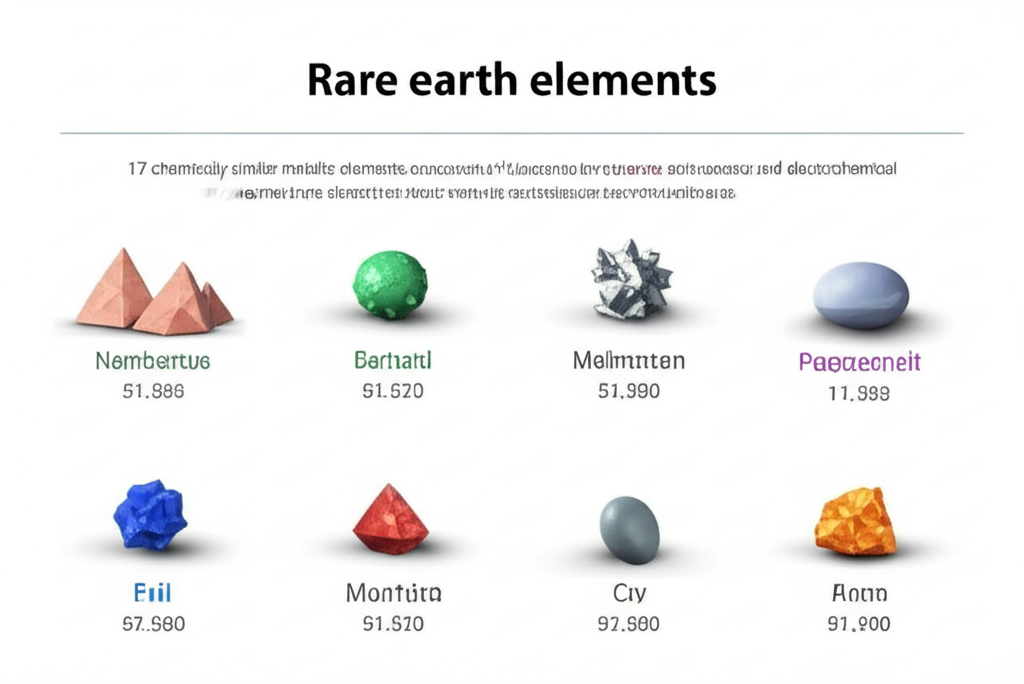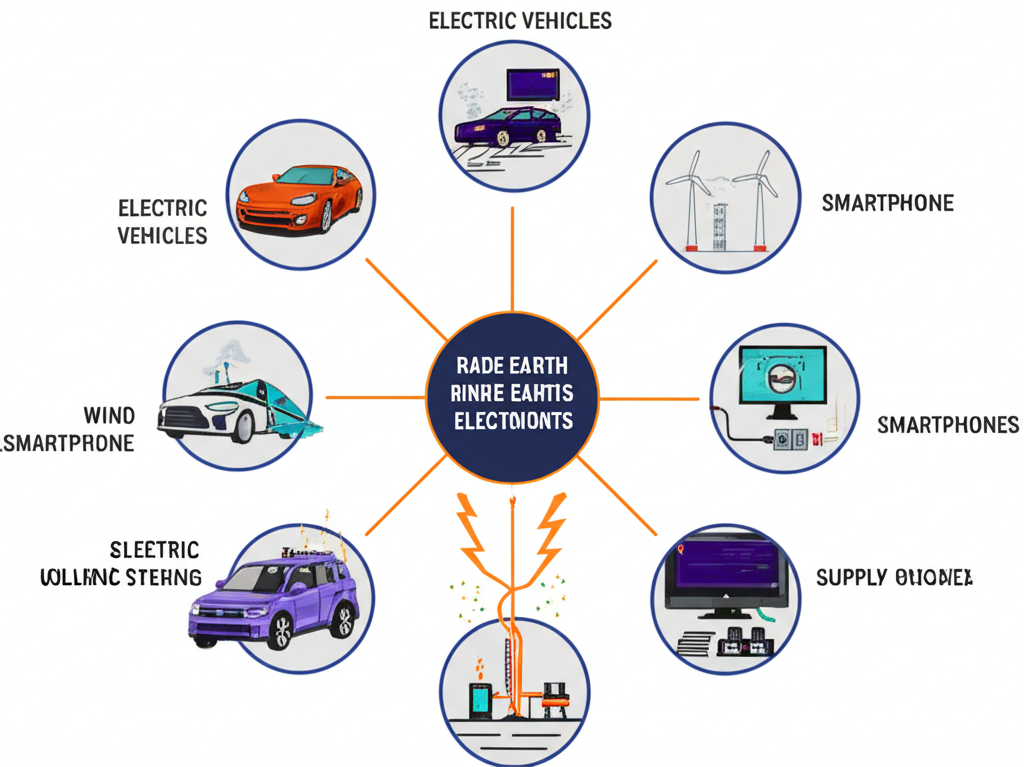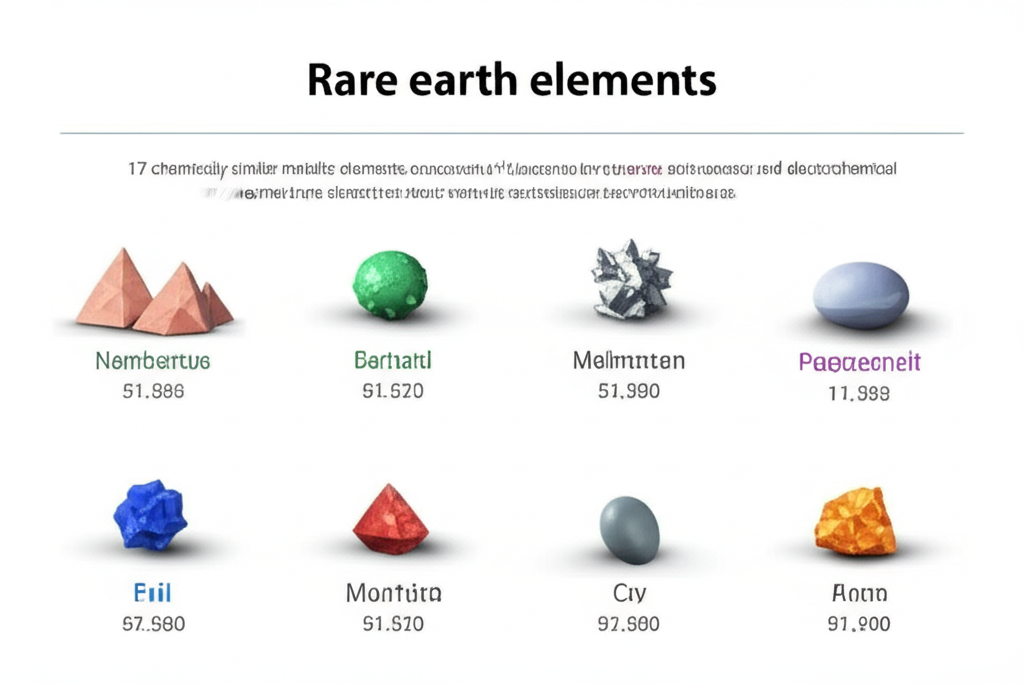The Strategic Importance of Rare Earth Minerals in Today’s Economy

Rare earth elements—comprising 17 chemically similar metallic components—are foundational to a wide range of advanced technologies due to their exceptional magnetic, luminescent, and electrochemical traits. Despite their misleading name, these minerals aren’t particularly scarce in the Earth’s crust. What makes them rare is the difficulty in locating deposits rich enough to justify commercial extraction. Their true scarcity lies not in abundance, but in accessibility. These elements power the backbone of today’s high-tech world, from consumer electronics to defense systems, making them a linchpin in both economic competitiveness and national security strategies.
The modern digital and clean energy revolutions rely heavily on rare earths. Neodymium and praseodymium, for example, are essential in crafting the ultra-strong permanent magnets used in electric vehicle motors and offshore wind turbines. Europium and terbium enable vibrant, energy-efficient displays in smartphones and televisions. As nations accelerate their shift toward renewable energy and electrified transportation, the global appetite for rare earths is soaring. Yet, this rising demand collides with a fragile supply chain, dominated by a single nation: China. This concentration has exposed critical vulnerabilities, prompting governments and industries to reevaluate how they source and secure these indispensable materials.
How to Invest in Rare Earth Minerals: Stocks vs. ETFs

For investors aiming to tap into the rare earth opportunity, two primary pathways stand out: direct investment in individual mining and processing companies or indirect exposure through exchange-traded funds (ETFs). Each path offers a distinct balance of risk, reward, and research requirements. The choice often hinges on an investor’s appetite for volatility, time available for analysis, and desire for portfolio diversification.
Investing in Individual Rare Earth Stocks
Buying shares in specific rare earth companies allows investors to target firms with strong project pipelines, technological advantages, or strategic geographic positioning. This strategy can yield outsized returns if a company successfully transitions from exploration to production or secures key supply contracts. However, it also amplifies risk. Many rare earth ventures remain in early development stages, facing long timelines, regulatory hurdles, and capital-intensive processes. Success depends on a range of factors—from the stability of host countries to fluctuations in commodity prices and environmental compliance.
Thorough due diligence is non-negotiable. Investors should assess a company’s financial resilience, proven reserves, processing capabilities, and exposure to heavy versus light rare earths—where the latter often command higher value due to scarcity and application specificity. A firm operating a fully permitted mine with downstream integration, for instance, presents a markedly different risk profile than a junior explorer with no revenue and unproven economics.
Investing via Rare Earth ETFs

For those seeking broader exposure without the burden of analyzing individual companies, rare earth ETFs provide a streamlined alternative. These funds aggregate capital to invest in a diversified basket of firms involved in rare earth mining, refining, magnet manufacturing, and related technologies. By spreading investments across multiple players, ETFs mitigate the impact of any single company’s failure or underperformance.
This model lowers the entry barrier for retail investors and offers instant geographic and operational diversification. Instead of betting on one company’s success, investors gain exposure to the sector’s overall trajectory. Performance tends to mirror broader trends in rare earth demand, policy shifts, and technological adoption, making ETFs a practical tool for those who want to participate in the sector’s growth without deep technical expertise.
Top Rare Earth Minerals Stocks to Watch
Although the rare earth sector remains relatively niche in terms of publicly traded equities, several companies have emerged as leaders across different segments of the supply chain. These firms represent varying risk profiles and strategic focuses, from raw extraction to high-value downstream processing.
| Company Name | Ticker | Primary Operations | Key REEs Produced/Focused On | Market Position |
| :—————— | :—– | :———————————————– | :————————— | :——————————————————————————————————————————————————————————————————————————————————————————————————– |
| **MP Materials Corp.** | NYSE: MP | Mining, processing, and refining | Neodymium-Praseodymium (NdPr) | Operates Mountain Pass mine in California, the only integrated rare earth mining and processing site in North America. Aims to restore full U.S. rare earth supply chain. |
| **Lynas Rare Earths Ltd.** | ASX: LYC | Mining, concentration, and refining | Neodymium, Praseodymium, Dysprosium, Terbium | One of the largest producers of rare earths outside China, with operations in Australia (Mt Weld mine) and Malaysia (advanced processing facility). Expanding processing capabilities globally. |
| **Neo Performance Materials Inc.** | TSX: NEO | Downstream processing and magnet production | Neodymium, Praseodymium, Dysprosium, Terbium, other specialty rare earths | A global leader in the manufacture of advanced industrial materials, including rare earth magnets and specialty chemicals. Focuses on the value-added segment of the rare earth supply chain, with facilities in Europe and Asia. |
Company Spotlight: MP Materials Corp.
MP Materials (NYSE: MP) holds a pivotal position in North America’s rare earth landscape. Its Mountain Pass facility in California is the continent’s sole integrated rare earth mine and processing operation. The company focuses on producing neodymium-praseodymium (NdPr) oxide, a critical feedstock for high-performance permanent magnets used in electric vehicles and wind generators.
What sets MP apart is its ambition to rebuild a fully domestic rare earth supply chain in the United States. While it currently exports concentrates for separation—mostly to China—it has launched significant initiatives to bring full refining and magnet manufacturing back to U.S. soil. Strategic partnerships with automakers and government-backed funding are accelerating this transition. Recent production increases and infrastructure investments signal strong momentum, positioning MP as a cornerstone of America’s efforts to reduce reliance on foreign processing.
Company Spotlight: Lynas Rare Earths Ltd.
Lynas Rare Earths (ASX: LYC) stands as the largest rare earth producer outside of China, operating the high-grade Mt Weld mine in Western Australia. The ore body at Mt Weld is among the richest known, allowing Lynas to produce consistent, high-quality output. Its downstream operations include a separation facility in Malaysia, with new facilities under construction in Texas and Australia, supported by U.S. and Australian government incentives.
Lynas supplies a broad spectrum of rare earths, including neodymium, praseodymium, dysprosium, and terbium—all vital for high-efficiency motors and green technologies. By expanding its footprint beyond Asia, the company plays a crucial role in global supply chain diversification. Its progress reflects a broader geopolitical shift, as Western nations prioritize secure and ethical sourcing of critical minerals.
Company Spotlight: Neo Performance Materials Inc.
Neo Performance Materials (TSX: NEO) operates at the high-margin end of the rare earth value chain. Rather than mining raw ore, the company specializes in transforming rare earth oxides into advanced materials such as hydrogen-powered magnet powders, rare earth alloys, and specialty chemicals. Its products are embedded in EV drivetrains, hard disk drives, and emission control systems.
With manufacturing facilities in Germany, Estonia, and China, Neo bridges the gap between raw materials and finished technology. This downstream focus insulates it from some of the volatility associated with mining, while aligning it closely with end-market demand. Investors gain exposure not just to mineral supply, but to the innovation and engineering that turn rare earths into real-world solutions.
Exploring Rare Earth ETFs: Key Players and Performance
For investors who prefer a hands-off approach, rare earth ETFs offer a practical route to sector exposure. These funds combine professional management with instant diversification, helping to smooth out the volatility inherent in individual stock picks.
VanEck Rare Earth/Strategic Metals ETF (REMX)
The VanEck Rare Earth/Strategic Metals ETF (REMX) is the most direct and widely followed investment vehicle targeting the rare earth and strategic metals sector. It tracks the MVIS Global Rare Earth/Strategic Metals Index, which includes companies deriving a significant portion of revenue from rare earth mining, refining, and recycling, as well as producers of other critical materials like lithium, cobalt, and titanium.
REMX offers exposure to a globally diversified portfolio, with significant weightings in firms based in Australia, the United States, and Canada—regions actively building non-Chinese supply chains. Its expense ratio of approximately 0.59% is competitive for a specialized sector fund. Historically, REMX has demonstrated strong performance during periods of heightened demand for clean energy tech and supply chain disruptions. However, it also reflects the sector’s inherent volatility, reacting sharply to shifts in commodity prices, policy announcements, and geopolitical tensions.
Comparative Look at Other Relevant ETFs
While REMX remains the benchmark for rare earth-focused investing, other ETFs offer alternative paths. The Global X Lithium & Battery Tech ETF (LIT), for example, targets companies in the lithium-ion battery supply chain, including battery manufacturers and EV component suppliers. While it includes some rare earth exposure, its focus is broader and less targeted. Similarly, general materials or clean energy ETFs may touch on rare earths indirectly but dilute exposure across less relevant sectors.
The distinction matters: REMX delivers concentrated exposure to firms deeply embedded in rare earth and strategic metal operations. For investors specifically targeting this niche, it offers a more precise tool than broader alternatives. Choosing between them depends on whether one seeks focused rare earth exposure or a wider bet on the energy transition.
Key Factors and Risks When Investing in Rare Earths
Entering the rare earth market requires more than just recognizing long-term demand. A host of structural, economic, and regulatory risks shape the investment landscape.
Geopolitical Dynamics and Supply Chain Security
China’s dominance in rare earth processing—controlling over 80% of global capacity—remains a defining feature of the market. While mining occurs in various countries, much of the ore still flows to China for separation and refinement. This imbalance creates strategic dependencies that nations like the United States, Japan, and members of the European Union are actively working to dismantle.
U.S. initiatives, including the Department of the Interior’s critical minerals list, underscore the national priority of securing domestic supply chains. Trade restrictions, export controls, and diplomatic pressures can all influence market access and pricing. Any disruption in Sino-Western relations could trigger supply shocks, making geopolitical risk a core consideration for investors.
Market Volatility and Commodity Price Fluctuations
Rare earth prices are notoriously volatile. Unlike commodities with transparent exchanges like gold or oil, rare earth markets lack centralized pricing mechanisms. Transactions often occur through private contracts, leading to opacity and price swings. Demand surges from EV adoption or wind energy projects can drive prices up rapidly, while new mine startups or shifts in Chinese policy can flood the market and cause sharp corrections.
This volatility directly impacts company revenues and stock performance. Investors must be prepared for wide swings and adopt a long-term view, focusing on structural demand trends rather than short-term price movements.
Regulatory and Environmental Challenges
Rare earth extraction is inherently complex and environmentally sensitive. The process often involves toxic chemicals, generates radioactive byproducts like thorium, and requires extensive water use. These factors lead to rigorous permitting processes, especially in jurisdictions with strong environmental protections.
Delays in approvals can stall projects for years, increasing costs and eroding investor confidence. Companies that fail to meet environmental standards risk fines, legal action, or project shutdowns. Conversely, those that invest in cleaner technologies and maintain strong community relations may gain regulatory favor and public support.
The ESG Landscape of Rare Earth Mining: A Differentiated Perspective
Environmental, social, and governance (ESG) criteria are no longer optional in the mining sector—they’re central to valuation, access to capital, and long-term viability.
Environmental Impact and Sustainable Practices
Traditional rare earth mining has left a legacy of pollution, particularly in regions with weak oversight. However, the industry is evolving. Innovations such as in-situ leaching, which minimizes surface disturbance, and closed-loop processing systems that reduce chemical discharge, are gaining traction. Recycling is another frontier: recovering rare earths from discarded electronics and end-of-life magnets could supply up to 25% of future demand, according to the International Energy Agency (IEA). Companies investing in circular economy models may gain a competitive edge.
Social Responsibility and Community Engagement
Rare earth projects often operate near indigenous communities or in ecologically sensitive areas. Ethical operations require more than compliance—they demand genuine engagement. This includes fair compensation, local hiring, and transparent dialogue about environmental risks. Firms that neglect social license risk protests, legal challenges, and reputational damage. In contrast, those that build trust can secure long-term operational stability.
Governance and Ethical Sourcing
Strong governance ensures accountability, reduces corruption risk, and supports ethical supply chains. Investors are increasingly scrutinizing board structures, executive compensation, audit practices, and anti-bribery policies. In a sector where supply chains cross multiple jurisdictions, traceability and transparency are essential. Certifications like IRMA (Initiative for Responsible Mining Assurance) are emerging as benchmarks for responsible production.
Future Outlook and Emerging Trends in the Rare Earth Sector
The rare earth market is far from static. Technological innovation, shifting policies, and evolving demand patterns are reshaping its future.
Technological Advancements in Extraction and Recycling
Breakthroughs in extraction technology promise to make rare earth production cleaner and more efficient. Bioleaching, which uses microbes to extract metals, and advanced solvent systems are reducing reliance on harmful acids. Meanwhile, urban mining—recovering rare earths from e-waste—is gaining momentum. Pilot programs in Japan and the EU have demonstrated the feasibility of recycling neodymium from hard drives and motors. As these technologies scale, they could reduce environmental harm and ease supply constraints.
Shifting Demand Drivers and New Applications
Electric vehicles and wind turbines will remain the dominant drivers of rare earth demand over the next decade. But new frontiers are emerging. 5G infrastructure requires rare earths for signal amplification and miniaturized components. Quantum computing research relies on specialized rare earth ions for qubit stability. Defense applications—from radar systems to stealth coatings—also depend on these materials. As technology advances, the need for specialized, high-purity rare earth compounds will only grow, reinforcing their strategic importance.
Conclusion: Making Informed Decisions in Rare Earth Investments
Rare earth minerals sit at the intersection of technology, sustainability, and geopolitics. Their role in powering the clean energy transition and next-generation electronics ensures long-term relevance. For investors, the sector offers compelling growth potential, but it’s not without complexity. Success requires navigating volatile markets, regulatory landscapes, and ESG expectations.
Whether through targeted stock picks or diversified ETFs, a thoughtful, research-driven approach is essential. Understanding where a company sits in the value chain, its environmental footprint, and its resilience to geopolitical shifts can make the difference between speculative risk and strategic opportunity. As the world races to decarbonize and innovate, rare earths will remain a critical, if challenging, frontier for forward-looking investors.
Frequently Asked Questions (FAQ)
What are rare earth minerals, and why are they important for investors?
Rare earth minerals are a group of 17 metallic elements crucial for high-tech applications like EVs, wind turbines, and electronics. For investors, their importance stems from their indispensable role in modern technology and the green energy transition, leading to high global demand and strategic value.
Which rare earth stocks are considered the best long-term investments?
Identifying “best” is subjective and depends on an investor’s risk tolerance. However, companies like MP Materials, Lynas Rare Earths, and Neo Performance Materials are often highlighted for their established operations, market position, and efforts in diversifying the supply chain. Long-term potential often lies with companies that have secure mining rights, robust processing capabilities, and strong environmental commitments.
How can beginners start investing in the rare earth minerals sector?
Beginners can start by investing in a rare earth ETF, such as the VanEck Rare Earth/Strategic Metals ETF (REMX), which offers diversification across multiple companies. This approach reduces individual stock risk. For those interested in individual stocks, thorough research into company financials, projects, and market position is essential before investing.
What is the current market outlook for rare earth minerals stock prices?
The market outlook is influenced by global demand for green technologies, geopolitical stability, and supply chain developments. While demand is generally strong, stock prices can be volatile due to commodity price fluctuations, trade policies, and new supply discoveries. A long-term perspective, focusing on fundamental growth drivers, is often recommended.

留言